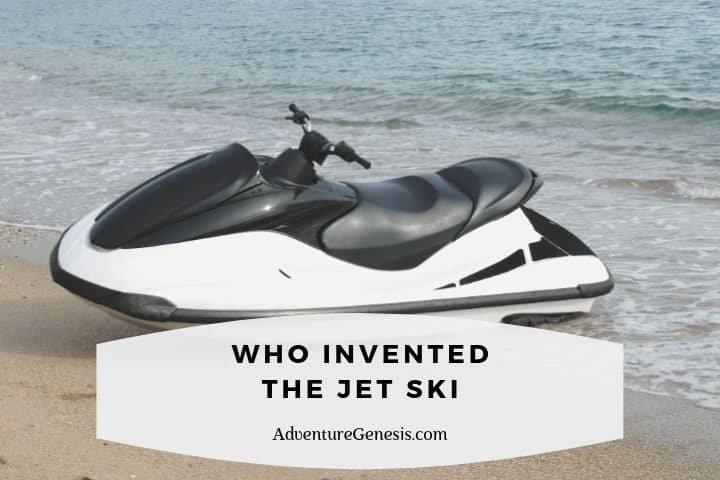You can have hours of fun riding your jet ski, the adrenaline pumping through your body and the rushing of the water all around you. Have you ever stopped to think who originally made the personal watercraft you enjoy so much? Maybe not, but now you’re curious. Who invented the jet ski?
Clayton Jacobson II is the creator of the jet ski. Jacobson, a Norwegian American, was involved in motocross, loans and savings, and wholesale food before making the first stand-up jet ski back in 1965. He went on to work with all three jet ski brands: Sea-Doo, Kawasaki, and Yamaha.
Curious to know more about Jacobson’s fascinating life? Perhaps you’re enthralled by all things jet ski and wish to dive into the history of this personal watercraft. You’re in luck. In this article, I’ll go in-depth on the thrilling backstory of how today’s jet skis came to be.
Let’s begin.
Who Invented the Jet Ski
As mentioned in the intro, Clayton Jacobson II, born on October 12th, 1933, made the world’s first jet ski. Although he’s partly Norwegian, Jacobson himself is from Portland, Oregon. Before he came into the world, his family had lived in Minnesota.
The Jacobsons wouldn’t stay in Oregon long. They migrated to Southern California, which at the time was touted as a land of opportunity. Finally settling in one place, Jacobson had a normal childhood, attending Manual Arts High School and later Los Angeles City College. He had a job at a garage and filled his spare time with street racing and bodybuilding pursuits.
In college, Jacobson studied engineering and physics. When he was done with his schooling, he decided to become a part of the Marine Corps Reserve, joining the Air Corps. He got stationed at Los Alamitos Army Airfield, where he was trained in jet engine technology and drafting.
Still, it would be several years before Jacobson would sit down and dream up what became the very first jet ski. After leaving the Air Corps, Jacobson moved on to a job in wholesale food, working in this industry for a while. Most importantly, he was introduced to his future wife Diane through this career, with whom he later had four kids.
Jacobson’s father-in-law got him a job in loans and savings, putting Jacobson one step further to his as-yet-unrealized jet ski dreams. During that time, he and his family relocated to Palos Verdes. Jacobson also began racing motocross, favoring the Mojave Desert in which to do so.
This hobby is what brought us to the creation of the jet ski.
What Is the History of the Jet Ski
Not only was the Mojave Desert brutally hot, but it maybe wasn’t the safest place for motocross racing, either. Jacobson found that out for himself the hard way when he got in an accident one day. It wasn’t serious, and it could have been much worse, especially considering that Jacobson wouldn’t use padded leather sleeves or jumpers while riding. This was in part because of the high temperatures of the desert region.
Jacobson mused after his accident, drinking beer in an irrigation ditch with a pal. He wanted a means of riding a motorcycle but without the risk of hurting oneself by crashing into the ground. What he envisioned, he referred to as a “motorcycle for the water”. He couldn’t wait to get home and draw out the ideas in his head.
There was a lot of passion behind this project. Jacobson exited his financial position to spend more time strengthening the design of his original jet ski. He eventually made a prototype as well. That occurred in 1965. This early version of today’s stand-up jet ski included a jet pump from Berkeley, a two-stroke engine from West Bend, an aluminum base, and a fixed handle pole.
Jacobson kept working on his jet ski, improving on his design by 1966 with another prototype. Bombardier Recreational Products, which mostly made snowmobiles, became interested in this jet ski. Bombardier would later branch off to Sea-Doo, a brand you surely know. Jacobson worked on a sit-down jet ski with a Rotax engine at 320cc and got it licensed. The company bought the license and ran with this version of the jet ski.
Through 1970, Jacobson would complete 12 jet ski prototypes, most stand-ups. He continued improving them still, adding abilities like self-righting and a handle pole that could move and pivot. This made riding the jet skis much easier than his original designs.
Sea-Doo wasn’t the only company that wanted a piece of Jacobson’s product. Kawasaki also wanted to work with him, but due to the Bombardier agreement, Jacobson’s hands were legally tied through 1971. Once that year came up on the calendar, Jacobson and Kawasaki struck an exclusive deal.
By 1973, his stand-up jet skis were sold in stores under the Kawasaki banner. That said, this agreement was a short-lived one, lasting until 1976. Kawasaki wanted to part ways, but Jacobson battled them legally over the rights to the licenses. In the end, Kawasaki won the rights.
Jacobson rebounded nicely, beginning a deal with Yamaha Motor Company by 1986. This time, he protected himself, ensuring the arrangement would last a decade per the contract. Jacobson’s official title through this agreement was that of a water vehicle division consultant.
Whether you prefer Sea-Doo, Kawasaki, or Yamaha jet skis then, you can thank Clayton Jacobson II for having his hand in the early jet skis produced by all three major brands.
Conclusion
The father of the jet ski is Clayton Jacobson II. In his earlier years, he was an avid motocross fan who, after an accident, wanted a vehicle like a motorcycle that promised less risk of injury. He came up with the jet ski, which he considered a motorcycle for the water.
Jacobson first worked with Sea-Doo, then Kawasaki, and finally, Yamaha. From stand-up to sit-down jet skis, Jacobson made them all. His dedication towards his work and passion for perfection led to an amazing creation. Although these days he doesn’t have his hand in jet ski work anymore, Jacobson still does awe-inspiring things. For instance, he traveled across the world in a Cessna 208 Caravan Amphibian plane, proving that his love of thrills hasn’t died down much.
The next time you go to ride your jet ski, remember that although there’s a big brand name on it, the personal watercraft wouldn’t have existed without Clayton Jacobson II.

